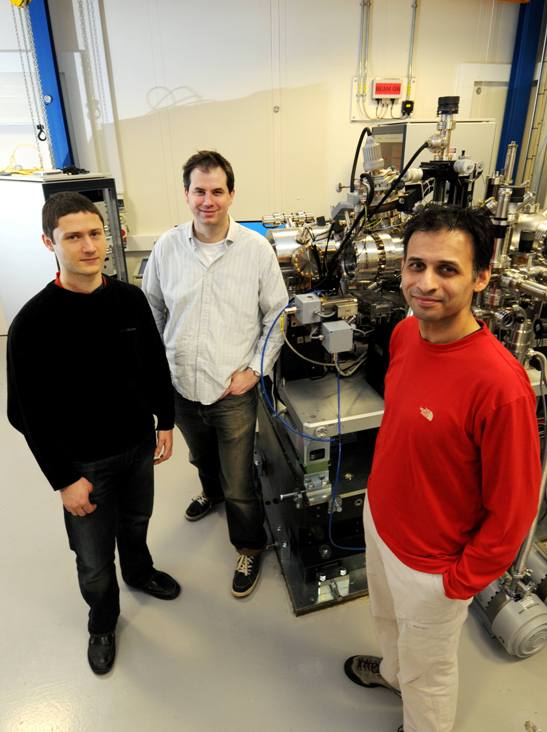Extending our knowledge of how magnetic materials behave on an atomic scale has led to considerable technological advances, particularly in the area of information storage. University of Leeds scientists have been working with the Nanoscience beamline team at Diamond to study the properties of magnetic domain walls, which are areas where the sample magnetisation rapidly changes direction. The ability to manipulate domain walls using an electric current has recently generated a great deal of interest since it is important for the development of spintronics and magnetic memory devices. Previously the group led by Christopher Marrows (from the University of Leeds) used the Nanoscience beamline to understand the detailed structure of domain walls and how this affects their motion when a current pulse is applied. Now the group have been back to demonstrate how the wall motion can be controlled and what happens when permalloy wires are doped with vanadium.
 |
| Serban Lepadatu and Chris Marrows from the University of Leeds with Sarnjeet Dhesi from Diamond on the Nanoscience beamline I06 |
The interaction between magnetic domain walls and a spin-polarised electric current, which causes them to move, is known as the spin-transfer torque effect. The spin torques acting on a domain wall consists of two contributions known as the adiabatic and non-adiabatic terms. The ratio of non-adiabatic to adiabatic term, β, is dependent on the material of the wire, and needs to be as high as possible since it is the non-adiabatic part of the torque that behaves as an effective magnetic field and is most efficient at moving a domain wall. The non-adiabatic torque dissipates energy, as does the well-known magnetic Gilbert damping, which is parameterised by another dimensionless number α. There are conflicting theories that argue whether or not these quantities arise from the same physics. By adding vanadium to permalloy wires the group were able to show that β increases, whilst α is unaffected, demonstrating that a class of theories that predict these two quantities to be related are not applicable in this case. This work has been published in the journal Physical Review B Rapid. Comm, and was performed in collaboration with scientists from Diamond, ISIS and the University of Exeter.
The group also carried out a series of experiments looking at controlling the spin-torque resonant frequency by lithographically engineering the size and shape of notches in the wire to effectively create a potential well. The spin-torque resonance effect allows the domain wall to resonate in a pinning potential at the point of the notch when an alternating current is applied. The eigenfrequency of the potential well is determined by restoring force from this potential, which this research showed to be controlled by the shape of the notch. At the resonant frequency, the domain wall becomes depinned at a much lower threshold current. This has important applications for magnetic memory devices, where binary data can be stored as either the presence or absence of a domain wall at the pinning potential.
Working with the Nanoscience beamline team the scientists were able to demonstrate domain wall resonators in operation with well defined, selectable resonant frequencies. The domain wall therefore can be treated as a quasi-particle acted on by a force which can be derived from the physical shape of the notch. A series of lithographically engineered notches along a wire could be used as a magnetic memory device or logic system without the need for costly external or variable magnetic fields. Also each domain wall could be manipulated individually, reducing the need for complex wiring. This work has also been published in the journal Physical Review B Rapid. Comm, and was picked out as an Editor’s selection. It was performed in collaboration with scientists from Diamond, ISIS, Imperial College, and IBM Research.
“These results show that there are still breakthroughs to be made in our fundamental understanding of this effect, and that it is very amenable for use in a new generation of spintronic memories and logic circuits based on domain wall physics.”Chris Marrows, University of Leeds
“This research exploits the full capability of the x-rays and PhotoEmission Electron Microscope (PEEM) on beamline I06. The images that Chris’s group recorded are amongst the most detailed we have taken and allow calculations to more fully understand the nature and formation of domain walls in the materials.”Sarnjeet Dhesi, Diamond Light Source
Domain-wall pinning, nonadiabatic spin-transfer torque, and spin-current polarization in permalloy wires doped with vanadium, S. Lepadatu, J. S. Claydon, C. J. Kinane, T. R. Charlton, S. Langridge, A. Potenza, S. S. Dhesi, P. S. Keatley, R. J. Hicken, B. J. Hickey, and C. H. Marrows, Physical Review B 81 (2), January 2010
DOI: 10.1103/PhysRevB.81.020413
Domain-wall spin-torque resonators for frequency-selective operation, S. Lepadatu, O. Wessely, A. Vanhaverbeke, R. Allenspach, A. Potenza, H. Marchetto, T. R. Charlton, S. Langridge, S. S. Dhesi, and C. H. Marrows, Physical Review B 81, February 2010
DOI: 10.1103/PhysRevB.81.060402
Diamond Light Source is the UK's national synchrotron science facility, located at the Harwell Science and Innovation Campus in Oxfordshire.
Copyright © 2022 Diamond Light Source
Diamond Light Source Ltd
Diamond House
Harwell Science & Innovation Campus
Didcot
Oxfordshire
OX11 0DE
Diamond Light Source® and the Diamond logo are registered trademarks of Diamond Light Source Ltd
Registered in England and Wales at Diamond House, Harwell Science and Innovation Campus, Didcot, Oxfordshire, OX11 0DE, United Kingdom. Company number: 4375679. VAT number: 287 461 957. Economic Operators Registration and Identification (EORI) number: GB287461957003.